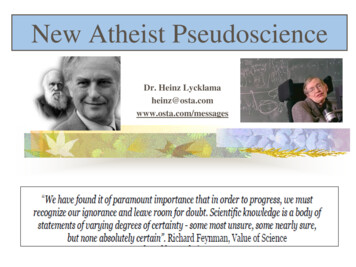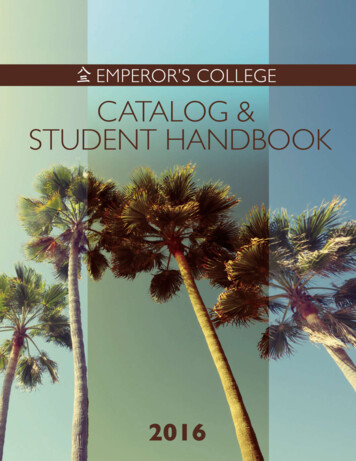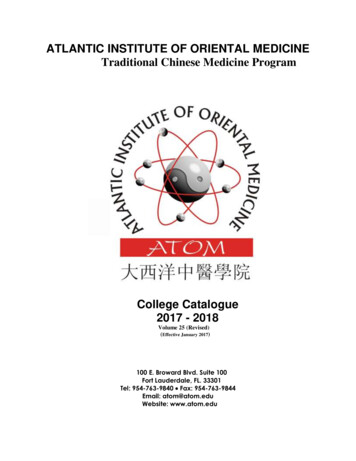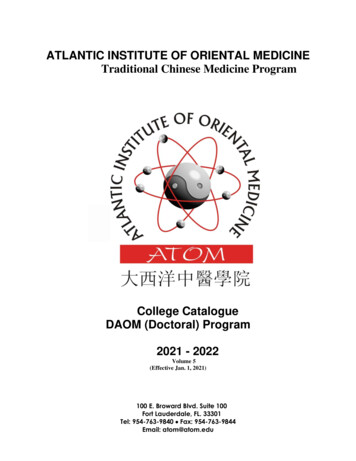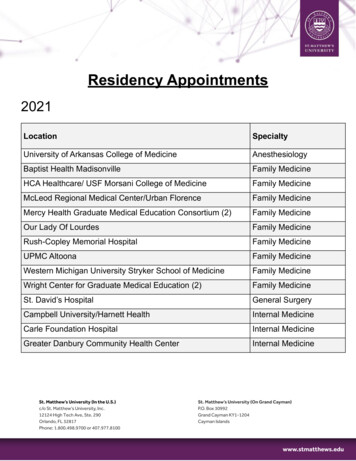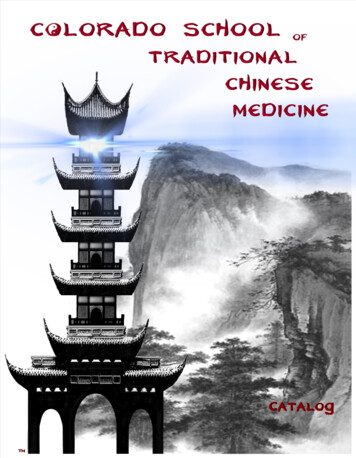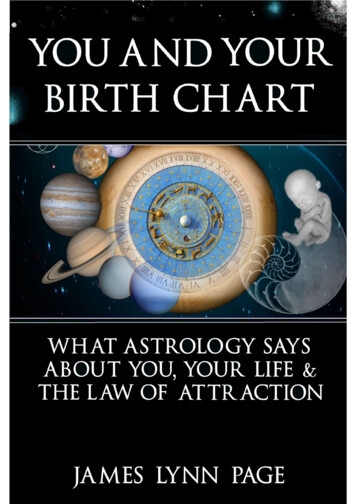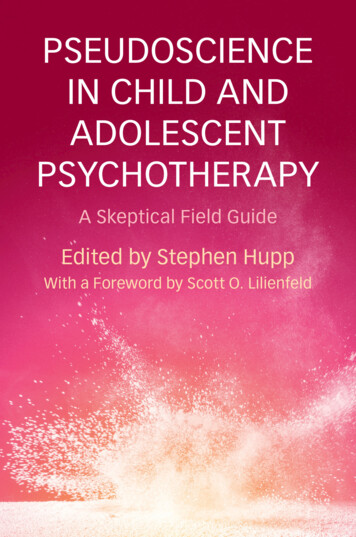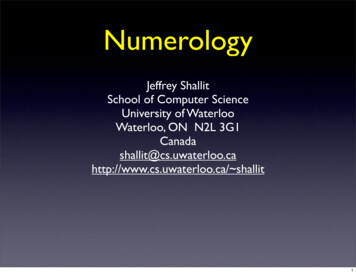
Transcription
Traditional Medicine andPseudoscience in China: A Reportthe Second CSICOP Delegation(Parti)In this, the first of a two-part report on a 1995 CSICOP delegation to China, theauthors discuss the historical rationale for Traditional Chinese Medicine (TCM), itsinvolvement with the questionable Qigong movement, and the growing importation tothe West of these practices by Western practitioners of "alternative medicine. "They present their observations of how TCM is practiced at the major TCM facility inBeijing and describe their visit to China's preeminent neurophysiology labstudying the neurochemical underpinnings of acupuncture effects.BARRY L. BEYERSTEIN a n d WALLACE SAMPSONIn 1988 the first C S I C O P delegation to China lookedinto the claims of several Qigong (pronounced cheegungy masters and their young proteges. These childmarvels supposedly possessed what Chinese admirers call"special ability" or "extraordinary functions of the humanbody." They were said to be able to alter the shape or colorof objects in sealed containers and perform a host of otherminor miracles. What the first CSICOP delegation (composed of most of the Executive Council at the time) foundwas that these children could not produce their effects under18luly/August 1996 SKEPTICAL INQUIRER
close observation. In short, the whiz kids and their masterswere performing unsophisticated conjuring tricks (Alcock etal. 1988). Also, in controlled tests, the delegation found thevaunted abilities of the Qigong masters to diagnose medicalailments to be unsubstantiated.elites, top party and military officials cynically kept for themselves the best treatments scientific medicine could offer.According to Mao's personal physician, Li Zhisui (Li 1994),Mao himself relied on Western methods to treat his many illnesses (except for a few folk practices carried over from hisrural childhood). Trained in scientific medicine at anAmerican-run medical school in China, Li immigrated toAustralia after World War II. He was working as a medicalDespite such failures, medical uses of Qigong have continued to gain popularity in China. Along with other facets ofTraditional Chinese Medicine (TCM), it has become increasingly fashionable in the Westofficer for an Australian shipas well. Most observers conping company in 1949 whensider TCM's growing reputahe was enticed to return totion in China in the decadesBeijing. Shortly afterward, hePaul Kurtz, Chairman of CSICOPfollowing the Communist revwas appointed Mao's doctor,The Committee for the Scientific Investigation of Claims of theolution (takeover in 1949) tothe post he held until Mao'sParanormal has cultivated a long-standing relationship with scientifichave been due primarily to adeath in 1976. Li had noand skeptical colleagues in China. It began in 1987, when Mr. Linmix of practical necessity andother patients than Mao,Zixin, editor-in-chief of Science and Technology Daily (China's largestcirculation scientific publication), visited CSICOP's headquarters (thenpolitical expediency on theMao's hypochondriacal wife,in Buffalo) and invited a delegation to visit China from Marchpart of Chairman MaoJiang Quing, and a few other21-April 3, 1988. The SKEPTICAL INQUIRER published three accounts ofZedong. With fewer thanMao family members and topthis significant visit: Paul Kurtz, "Testing Psi Claims in China: Visit by a30,000 scientifically trainedparty officials. For them, LiCSICOP Delegation"; James Alcock. Kendrick Frazier, Barry Karr, Philipphysicians in all of Chinahad the latest Western drugs,J. Klass, Paul Kurtz, and James Randi, "Preliminary Testing" (bothSummer 1988); and Paul Kurtz, "The China Syndrome: Further(most of them concentrated insurgical techniques, and medReflections on the State of Paranormal Belief in China" (Fall 1988).the large cities and sufferingical equipment at his disposal,from politically suspect classSince that time. Mr. Lin spent a year in Amherst. New York, andand a well-equipped portablefrequently visited CSICOP headquarters and the adjacent Amherstbackgrounds), die Communisthospital that accompaniedcampus of the State University of New York at Buffalo. A Chinese delrevolutionaries were facedMao and his entourage onegation composed of members of China's Popular Science magazinewith an immediate need to betheirfrequent, impulsiveand association visited the United States, and six members of thisseen as "doing something"romps around the vast coundelegation participated in a CSICOP conference in Dallas and visitedabout the dismal state of medskeptical groups in Boulder and Los Angeles.tryside.ical care in China at die time.In an effort t o maintain contact, our Chinese colleagues indiAlthough the health ofcated a desire for a third visit. Barry Beyerstein, Wallace Sampson,With the economy devastated,and Andrew Skolnick made the trip. We are glad t o publish the firstthe masses did begin tohard currency almost nonexispart of their article below. Part 2 will be published In the next issue.improve following the revolutent, and hostility emanatingA delegation of six Chinese researchers are participating in thetion, the herbal remedies,from most foreign capitals, thefirst World Skeptics Congress in Amherst, New York, in June 1996.acupuncture, and moxibusnew regime saw little hope ofWe are also pleased that with this issue we will begin listingtion 2 dispensed by Mao'ssoon being able to affordtwo contact groups in China. I should point out that the Chinese"barefoot doctors" probablyhave published translations of many articles and books by skeptics.Western medical technologyWe hope to continue our dialogue.contributed much less to theand pharmaceuticals for aimprovement than severalpopulation that was already approaching 600 million. Thusphenomenal efforts in the public health sphere (after all, folkthe Communist Party began a concerted effort to convince themedicine had been the only treatment available to the massesmasses that TCM, like other aspects of Chinese culture, wasup to that time and the state of their health had been far fromnot merely equivalent but superior to decadent "imperialist"encouraging). Recruited from the peasantry, the "barefootalternatives. This of course carried the added political bonus ofdoctors" were armed with exhortations from the ubiquitousfostering national pride and solidarity among a war-weary andbooklets of Mao's quotations and training roughly equivalentfractionated people.to that of first aid attendants in the West. They organized vastand successful communal health projects. Sanitation facilitiesBut while T C M was being touted to the masses by theand access to safe drinking water were greatly improved andseveral parasitic epidemics were brought under control. At theBarry L. Beyerstein is associate professor of psychology and a mem- same rime, the spread of sexually transmitted diseases was conber of the Brain Behavior Laboratory at Simon Fraser University tained and greater social stability allowed improvements in(Burnaby, B. C, V5A 1S6, Canada). He is a Fellow and memberdiet, perinatal caic, and basic immunization (Horn 1976;of the Executive Council of CSICOP. Wallace Sampson is clini- China Report 1983).cal professor of medicine at the Stanford University School ofMedicine (Division of Hematology!Medical Oncology, SantaT C M had been the treatment of the Chinese people sinceClara Valley Medical Center, 751 South Bascom Avenue, Santa ancient times,' but having gained Mao's somewhat cynicalimprimatur, TCM's leaders began to amass increasing politicalClam, CA 95128). He is the board chairman of the Nationalpower in the new China. Western journalists who accompaCouncil Against Health Fraud and a Fellow of CSICOP.IntroductionSKEPTICAL INQUIRER July/August 199619
nied Richard Nixon during his historic rapprochement withto replace the scientific worldview with mystical beliefs and, inthe Chinese government were intensively courted by the T C Mparticular, their willingness to credit virtually any healingestablishment, as were later delegations of Western doctorsclaims, providing they are ancient or hail from exotic places.(China Report 1983; Skrabanek 1985). These delegationsTCM's growing r/opularity in Europe and North Americawere shown major surgery being performed wirJi acupunctureis widely recognized. Its shaky scientific foundations and ecoanesthesia. When columnist James Reston required an emernomic and politically driven push for legitimacy are perhapsgency appendectomy during Nixon's visit, he was widely,less well known. When the authors' trip to China was conthough erroneously, believed to have been given onlyceived, the movement to make T C M part of the therapeuticacupuncture as a pain killer during the surgery. It was not untilmainstream in the West had already been 20 years in gestation.much later mat it was revealed that the Chinese surgicalBy 1995, the U.S. Office of Alternative Medicine had beenpatients observed by foreign delegations had been preselectedcreated by Congress (not by scientists, it should be noted) andfor high pain tolerance and heavily indoctrinated beforehand.'was sponsoring alternative medicine projects that wereIt was also disclosed that these demonstration cases were rouexpected to provide hard evidence to justify some of thesetinely administered surreptitious doses of morphine in antreatments.6 TCM practitioners have recently requested thatintravenous drip that supposedly contained only hydratingthe U.S. Food and Drug Administration upgrade acupunctureand nourishing fluids (Keng and Tao 1985). In addition, it hasneedles from the "investigative device" category, and Congresssince come to light that much of thehas just passed a bill upgrading theapparently objective and well-conofficial medical status of these neetrolled research on T C M emanatingdles. U.S. schools of TCM. felt byfrom Chinese medical schools duringmany to be diploma mills, are gradudie tumultuous era of the culturalating practitioners who clamor forrevolution (1966-1976) was falsifiedlicensure. Twenty-eight states haveat the behest of the hospitals' scientifalready licensed lay acupuncturists,ically unqualified political commisand most states allow physicians tosars to ensure that the "research"perform acupuncture. Some stateswould support the party line.allow lay acupuncturists to be "primary care physicians" for industrialDespite this prevarication, mostinjuries (and be paid the same asexperts today concede that acupunclicensed M.D.s and D.O.s). Seventure does have some analgesic properstates now have laws allowing anyties (though its potency has been"licensed practitioner" to use anygreatly exaggerated). Similarly, manymethod he or she wishes, as long asherbal remedies have already beenthe patient is informed in advanceassimilated into scientific medicine/that the treatment lacks scientific valOn the other hand, proof for the A ward at the Acupuncture Clinic in the China AcademyTraditional Chinese Medicine in Beijing. Patient withidation.hyperbole served up by some profes- ofacupuncture needles inserted in his leg for treatment ofsors of acupuncture from the TCM musculoskeletal problems. Next to his bed can be seenLikewise, unproven and possiblyinstitutes Barry Beyerstein toured dur- the electronic stimulator for delivering current pulsesdangerous herbal remedies are widelythrough the inserted needles. (Photo: Barry Beyerstein)ing a visiting professorship in China insold in health food stores, herbalist1990 remains as elusive as ever. For example, he was told thenshops, and by mail order in the U.S. and Canada. These prodthat acupuncture can cure cholera, deafness, paralysis, cataracts,ucts evade the regulations, which require prescription drugs toand mandibular overbite, among other things. Although thedemonstrate their safety and efficacy scientifically, by means ofevidence was lacking, claims like these appealed to deep-seateda loophole that permits herbal remedies to be marketed aslongings in certain social movements that were emerging in the"food supplements."West during the 1970s. The "New Age" movement is only theA bill before the U.S. Congress would legitimize alllatest in die long history of Western movements populated byunproven remedies in all states; and no longer would use of sciseekers who have turned to the East for answers in times of disentifically discredited treatments be grounds for discipline byillusionment. As Huston (1995) has noted:professional boards. Practitioners of T C M stand to gainimmensely from these political gambits. Much of the willingness of North Americans to support these trends has been dueThe history of Sino-American relations is in part a story ofAmericans looking to the East and interpreting a huge, comto uncritical media reports concerning the extent and effectiveplex and, to an outsider, confusing culture in such a way thatness ofTCM in China today. As several members of the Chinesethey see what they desire and fear die most.scientific community became aware of these shifting attitudes inthe West, they began to worry that their reputations were beingAmong New Agers in Europe and North America, theretarnished abroad by the growing acceptance of the media-drivenwas an eagerness to embrace the "natural" and "holistic" phinotion that Chinese medicine was undergoing a wholesalelosophy they perceived in TCM. It fit nicely with their desirereversion to its ancient, mystical roots. Thus it seemed a muru-20July/August 1996 SKEPTICAL INQUIRER
ally advantageous time for a North American team to look intodie status of T C M in China. An invitation from the ChineseAssociation for Science and Technology (CAST) to theseauthors and Andrew Skolnick, associate news editor of theJournal of the American Medical Association, afforded us thatopportunity. CAST has long been a foe of pseudoscience inChina and welcomed the opportunity to strengthen the cooperative ties it had already forged with CSICOPWhat is Traditional Chinese Medicine (TCM)?called "meridians." By balancing Qi in this way, they say,health is maintained or restored. Some of the means forachieving this balance can look rather strange to those accustomed to scientific medicine. Take, for instance, somethingwidely sold in China, the "505 Magic Bag." It is "shaped likean apron and, containing 50 [herbal] ingredients, [it] can prevent and treat many diseases of the stomach and intestines. . . [when] the bag [is worn] close to the navel" (Hou 1991).7Critics have pointed out that T C M relies, even today, on anancient philosophical view of the body that was formulatedduring an era when the Chinese, for religious reasons, wereforbidden to dissect cadavers. Thus the organ systems referredto in the ancient texts that still underlie TCM's practices aremerely metaphors that bear little relationship to the anatomical systems revealed by Andreas Vesalius, William Harvey, andthe other pioneers of scientific medicine.' Chinese medicineof 3,000 years ago was certainly nomore primitive than the folk practices from the same era thatevolved into Western medicine;but just as we no longer rely on theastronomy of ancient Greece, itwould seem that progress inanatomy, physiology, pathology,and therapeutics has rendered mostancient medical practices obsolete.For those who would argue thatantiquity implies validity, considerthe longevity of racism, sexism, orthe belief in a flat Earth.Every culture, including the Western culture, has evolved anindigenous system of folk healing (Atkinson 1956). Because ofthe body's natural restorative processes and the power of theplacebo effect, many physiologically inert folk remedies havelong enjoyed unearned credit for curing diseases. It is only in themodern scientific era that it has beenpossible to separate truly effectivetreatments from only apparently effective ones by means of double-blind,random-assignment,placebo-controlled tests. When submitted to adequate clinical trials, some ancient folkremedies have proven their worth;many more have not (Nolen 1974;Stalker and Glymour 1985; Skrabanekand McCormick 1990; Randi 1989;Barrett 1990; Pantanowitz 1994). Itwas our desire to see what progress theChinese were making in scientificallyAlthough T C M is based on aevaluating traditional treatments thatphilosophicalrather than empiricalmotivated our tour of the major TCMunderstandingof bodily function, itcenters in Beijing and Shanghai duringispossiblethatsome of its sethe summer of 1995.Medicine in Beijing, A centuries-old herbalist's manual isduresmightstillwork, but for reaPractitioners of T C M consider it preserved in an elaborate folding protective cover. (Photo:sonsunrelatedtothe magical beliefBarryBeyerstein)an empirical "science" of healing thatsystemthatsuppliedtheir rationalehas proved its worth in Asian counthousands of years ago (Xie 1995). Open-minded physicianstries for more than 3,000 years (Wallnofer and voneverywhere would welcome any treatment that could benefitRottauscher 1975). According to Chinese government figures,their patients, regardless of its origins—providing it can demonthere are now more than 2,000 TCM hospitals throughout thestrate its value in properly controlled clinical trials. It was in thiscountry (Hou 1991). Unlike Western scientific medicine,spirit that we approached the fact-finding mission that took uswhich aims to identify and counteract specific pathogens forto the foremost TCM facilities in the People's Republic.different disease states, T C M views all illnesses as the conseWe had been aware for some time that Chinese Qigongquence of a unitary cause, namely an imbalance of vital enermasterswere amassing considerable wealth and political powergies in the body. The term Qi, which translates roughly asbyallegedlyhealing people with mysterious force fields—sup"divine breath," refers to these putative energies, which arcposedly"external"manifestations of their Qi "energy." Manyassumed by T C M to permeate everything in the universe.masterssubsequentlyimmigrated to North America whereWith respect to biological organisms, Qi is rather like the contheyestablishedevenmorelucrative healing ventures. Qigongcept of elan vital, a hypothetical "life force" that was abanmasterswerefeaturedinBillMoyers's highly acclaimed butdoned in Western medicine when scientific discoveries madeembarrassingly credulous 1993 public television series,it apparent that there is no essential difference in chemical"Healing and the Mind." Appearing with Moyers on one segconstituents or processes between living and inanimate matter.ment was David Eisenberg, who enhanced his already highTCM's advocates assert that herbs, moxibustion, massage,standing in the alternative medicine community by promotingbreathing exercises, acupuncture, and certain foods are able tothe powers of the Qigong mentor, Master Shi. Moyers'srestore the balance of the Yin and Yang, variants of Qi energy,demonstration made it appear that Shi, this elderly, frail man.which are supposed to flow in invisible channels in the bodySKEPTICAL INQUIRER July/August 199621
had the strength to resist vigorous shoving by his hearty youngstudents, whereas he could apparently "push" them aroundfrom a distance with the invisible force of his external Qi. Ourstudy of slow-motion replays led us to conclude that the student was not exerting any great muscular force on the master'sbody, but was only pretending to do so.' At one point, eventhe trusting Eisenberg is heard to shout, "Try harder. You looklike you are faking it." In response to the master's movements,another student leaped backward, making it appear that themaster's "energy" had repelled him without physical contact.Peter Huston, writing in the September/October 1995SKEPTICAL INQUIRER ("China, Chi, and Chicanery") reachedthe same conclusion that we did from studying this performance. It looked like a well-rehearsed ballet. Various stagetricks passed off as miracles by Qigong masters have beenrepeatedly exposed by Chinese investigators, who were amongour hosts during our tour of China(Lin et al., in press).invoked it to diagnose illnesses, it is the same "energy" thatT C M advocates say runs dirough acupuncture meridians toeffect healing. It has always struck us as odd that proponentscan accept that this mysterious energy is unable to interactwith the physical matter in the sensors of measuring instruments (which could confirm its existence) while it is still ableto interact with the physical matter of bodily organs to "read"their state of health and produce a cure.It was against this background of mysticism, naive trust intestimonials, prior incidents of fakery, and a host of intertwined political and ideological considerations that we set outto look into TCM's claims ourselves. We wanted to see ifQigong and other T C M practices were as fully integrated withscientific medicine in the Chinese health care system as proponents on this continent assert." We had hoped to observeherbal prescribing, traditional pulse and tongue diagnoses,cupping, moxibustion, "back scraping," and the use of acupuncture foranesthesia, analgesia, and treatmentof organic disorders. Some of thesewe saw and others we did not, sinceour hosts in the T C M institutionsselected our itineraries for reasonssteeped in philosophy, politics, andcourtesy.Eisenberg's 1982 book, Encounterswith Qi, recounts the postgraduatetraining in TCM he received inChina. In the book he describesmany supposedly proven paranormalfeats performed by Qigong masters.'0Although he makes a few tokenproclamations of skepticism, Eisenbergseems curiously loath to ask the masOur Visitters to recreate the effects heobserved under conditions thatBeijing: June 1995. While we werewould prevent the kind of stagein Beijing, we enjoyed the superbtricks the demonstrations clearlyhospitality of Madam Shen Zhenyuresembled. In Encounters with Qi, heof CAST (the principal organizer),unquestioningly accepts the theraMr. Lin Zixin (former editor ofpeutic benefits of balancing theScience and Technology Daily and aResearch poster, laboratory of Dr. Han Jisheng. Neurosciencebody's (internal) Qi with herbs, Research Center, Beijing Medical Center. The poster depictsCSICOP Fellow), Madam Shenacupuncture, and moxibustion (also biochemical effects of acupuncture discovered in Han's laboZhen-xin (of the Academia Sinia),an herbal treatment). When he ratory. (Photo: Barry Beyerstein)and Mr. Bai Tongdong, a graduatereturned to China with Moyers, Eisenberg continued tostudent at Beijing University.embrace die dierapeutic effects of T C M as enthusiastically asWhile touring the Forbidden City with us, Mr. Bai, ahe had back in his student days when he accepted as real thephysicist and graduate student in the philosophy of science,kind of "external Qi" effects others have exposed as magicset die tone for our later discussions with his assertion that Qitricks. Moyers seemed equally willing to credit the healingis a philosophy, not a reflection of physical reality. In his view,powers of Qi on the basis of nothing; more than patient testithe principles of TCM, including Qi, are merely useful,monials and the word of his guides. Eisenberg now directssocially determined metaphors for the realities and facts thatalternative medicine courses for medical students and physionly science can provide. He did not offer opinions on diecians through Harvard University. These courses and a 1993validity of traditional Chinese medicine.article he coauthored on alternative medicine (Eisenberg et al.1993) were funded by the Fetzer Institute, a 200 millionendowment for the propagation of various unproven"mind/medicine" principles.The effects shown on Moyers's program were said to be driven by "external Qi," the same doubtful force invoked toexplain allegedly supernatural feats, (extraordinary functionsof the human body) that the 1988 CSICOP delegationexposed as conjuring tricks. Although the delegation foundthis "force" dismally inaccurate when the Qigong masters22July/August 1996 SKEPTICAL INQUIRERThe morning of our first full day, we were taken to a majorhospital and research institute at Beijing Medical University.There we were greeted by Professor Han Jishen, a worldfamous neurophysiologist, and several other distinguishedfaculty members. Dr. Han proceeded to chair a seminar thatincluded descriptions of the institute, its achievements in bothWestern and traditional Chinese medicine, and discussionamong ourselves and the assembled faculty.One of the speakers was Dr. Xie Zhu-fan, director of theInstitute of Integration of Traditional Chinese Medicine and
Western Medicine. In his presentation he oudined three historical phases in die resurgence of TCM in China. Dr. Xie didnot mention the political contributions to this renaissance,merely saying diat in the early 1950s T C M began to be taughtafter decades of neglect and that some Western-trainedChinese physicians had been released from their duties tostudy TCM. After this, he said, there followed a perioddevoted to documenting die clinical effects of TCM. Dr. Xieadmitted, as he does in his recent book (Xie 1995), that T C Mphilosophy is not compatible with modern science; but thatacupuncture and some other traditional techniques have beendemonstrated clinically to have analgesic properties or positiveeffects on certain functional disorders.whether the cellular effects of acupuncture found in the animal experiments could legitimately account for the myriadclinical effects in human patients claimed by practicingacupuncturists.A detailed account of Dr. Han's research is beyond thescope of this article, but we can summarize some of his work,which has been widely published and presented at international conferences (e.g., Chen et al. 1994). Dr. Han showed,before the discovery of the enkephalins (the brain's endogenous morphinelike neurotransmitters), that acupuncturecaused a reduction in pain responses in rabbits and that transfusing a treated animal's cerebrospinal fluid into a nontreatedanimal produced a similar effect in the second rabbit. It wassuggested that acupuncture had elevated the pain threshold bytriggering a release of a transmissible agent (later identified asthe opioid peptides, enkephalin and endorphin). Dr. Hanlater showed, by using antisenseDNA in the system, that the ability of acupuncture to produce analgesia [lowered sensitivity to painwhile conscious] can be preventedby blocking the expression of theendorphin receptor on the surfaceof spinal neurons. Others haveshown that endorphin-blockingdrugs also reverse acupunctureanalgesia.According to Dr. Xie, the Chinese arc now in the thirdphase, the investigation of mechanisms that could account forTCM's clinical effects. For example, he said they had confirmed the ability of certain Chineseherbs to dilate blood vessels, decreaseplatelet activity (inhibit blood clotting), and "modulate immuneresponses." Because of the multipleactions of herbs, each could be usedfor several different disorders. Dr. Xiedid not explain how these effects hadbeen determined: whether the mixtures raised or lowered blood pressureand just how "immune system modulation" (we're not sure exacdy whathe meant by this term) benefits thepatient. There was no discussion ofside effects. Here, and during our discussions with other T C M physicians,it seemed axiomatic that when herbalmedications are ingested, only desirA ward at the China Academy of Traditional Chinese Medicineable outcomes follow.12in Beijing. Patient is being treated for a gastrointestinal problemMore rccendy, Dr. Han's grouphas shown that the peptide neurotransmitter cholecystokinin (CCK—receptors for which are believedto be distributed in close proximityto those for the endorphins) antagonizestheendorphin-relatedeffects of acupuncture. It seems tousing a process called moxibustion. The wooden box containsAfter the opening seminar, we smoldering herbs on a meshwork bottom that is in contact with do so by altering the endorphinreceptor's affinity for its transmitwere taken on a tour of Professor the skin of the patient's abdomen. (Photo: Barry Beyerstein)ter,oritsabilitytoconductmessages inside the cell. Dr. HanHan's laboratory. Dr. Han heads an institute with a staff ofthinksthatnaturalhyperactivityof the CCK system in aboutthirty-seven that occupies three floors of one campus building.10to20percentofthehumanpopulationis responsible forHis support comes primarily from governmental grants, e isbeing few, if any, independent sources of funding in belongstoDr. Han also has grants from the National Institute on Drugthatgroupofnonresponders.Abuse in the U.S. and Upsa Laboratories, a French pharmaceutical company. We met several of his collaborators, whomwe observed in their labs. Although the lab appointments weresimple, they were serviceable. The hallways were dimly lit bysingle, sparsely distributed fluorescent lamps, electricity apparently being expensive. Much of the lab's equipment had beendonated by an admirer of Dr. Han's, the distinguished opiateresearcher, Avram Goldstein, who shipped his furnishings andapparatus to Beijing after retiring from Stanford University.The institute's walls were decorated with poster presentationsfrom research meetings that described the lab's discoveries.Professor Han spent two more hours with us, touring the laband summarizing the work of his group on the physiology andneurochemisrry of acupuncture. Our interest was to seeOur visit was too short to assess the adequacy of themethodology or the validity of these studies, although theyseemed sound and have been published in peer-reviewed journals. Nonetheless, we felt that although this research is important basic science, it does not bear directly on many of theclinical claims made by acupuncturists. For instance, a rise inendorphin levels has been attributed to a number of variedac
Barry L. Beyerstein is associate professor of psychology and a mem-ber of the Brain Behavior Laboratory at Simon Fraser University (Burnaby, B. C, V5A 1S6, Canada). He is a Fellow and member of the Executive Council of CSICOP. Wallace Sampson is clini-cal professor of medicine at the Stanford University School of
